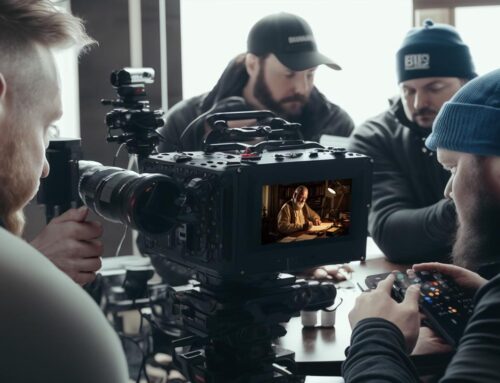Introduction
As we continue to navigate through the digital age, brands are constantly seeking out innovative ways to engage and captivate their target audience. One such innovation that is gaining considerable traction is the 360-degree video marketing. This form of marketing offers a fully immersive experience, allowing viewers to explore a virtual environment from every angle, hence the term “360-degree”. The 360-degree video marketing technique is transforming how brands tell their stories and how consumers interact with these narratives.
In this article, we will delve deep into the world of 360-degree video marketing, exploring its features, benefits, how brands can leverage this tool, and the future prospects of this immersive technology. If you’re a marketer or a brand owner seeking new and engaging ways to communicate your brand story, or an enthusiast wanting to understand the latest trends in digital marketing, this article is your comprehensive guide.
We will cover everything from the basic concept of 360-degree video marketing, to its application in various industries, the tools and platforms you can use to create 360-degree videos, and a variety of case studies showcasing successful 360-degree video marketing campaigns. By the end of this article, you’ll have a firm grasp of what 360-degree video marketing is, and how you can use it to enhance your brand’s digital presence and engagement.
Table of Contents
- What is 360-Degree Video Marketing?
- Benefits of 360-Degree Video Marketing
- Industries Leveraging 360-Degree Video Marketing
- Tools and Platforms for Creating 360-Degree Videos
- Case Studies: Successful 360-Degree Video Marketing Campaigns
- The Future of 360-Degree Video Marketing
- Final Thoughts
What is 360-Degree Video Marketing?
360-degree video marketing is a form of video marketing technique that utilizes immersive technology to create a completely spherical video experience. Unlike traditional videos, which provide a fixed perspective, 360-degree videos allow viewers to control their viewpoint and explore the video’s environment in all directions – up, down, left, right, and even behind.
These videos are created using a special set of cameras that capture a scene from all angles simultaneously. The footage is then stitched together to create a seamless, spherical video that can be viewed on a variety of platforms, including social media platforms like Facebook and YouTube, Virtual Reality (VR) headsets, and even on standard web browsers.
In a marketing context, 360-degree videos offer an innovative way for brands to showcase their products, services, or experiences. They can be used to take viewers on a virtual tour of a property, provide an immersive product demonstration, or take consumers behind the scenes of an event or experience. The immersive nature of these videos allows brands to create a more engaging and interactive experience for viewers, thereby driving greater audience engagement.
What sets 360-degree video marketing apart from other forms of digital marketing is its interactivity. Instead of passively watching a video, viewers can interact with the content, choosing what they want to see and when they want to see it. This level of control enhances viewer engagement and makes the experience more memorable.
In a nutshell, 360-degree video marketing is about leveraging technology to tell richer, more engaging stories, and provide consumers with unique, immersive experiences that resonate on a deeper level. It’s a powerful tool that, when used effectively, can help brands stand out in a crowded digital landscape.
Benefits of 360-Degree Video Marketing
360-degree video marketing offers a host of benefits that can enhance a brand’s marketing strategy. Here are some of the key advantages:
1. Enhanced User Engagement
360-degree videos are interactive and immersive, encouraging viewers to interact with the content, which can lead to increased engagement. Unlike traditional videos, where viewers passively watch the content, 360-degree videos offer a sense of active participation.
2. Stand Out in the Crowd
In the crowded digital space, it’s crucial for brands to differentiate themselves. By providing a unique, immersive experience, 360-degree videos can help brands stand out, capture audience attention, and leave a lasting impression.
3. Improved Information Retention
Studies suggest that immersive experiences can lead to better information retention. This is particularly beneficial for educational content, product demonstrations, or any video where conveying information is key.
4. Accessibility and Reach
With platforms like YouTube and Facebook supporting 360-degree videos, brands can easily share these immersive experiences with a large audience. Furthermore, viewers don’t need any special equipment to watch 360-degree videos – they can be viewed on regular web browsers, mobile devices, or with VR headsets for a more immersive experience.
5. Better Conversion Rates
360-degree videos provide a more detailed view of products or experiences, which can help customers make informed decisions. This, coupled with increased engagement, can potentially lead to higher conversion rates.
6. Create a Sense of Presence
360-degree videos can simulate a sense of presence, making viewers feel as if they are part of the scene. This can be especially useful for industries like real estate, tourism, and events, where giving viewers a realistic “feel” of a space or experience is beneficial.
7. Cost-Effective Virtual Reality Experience
While creating a full-fledged virtual reality (VR) experience can be expensive, 360-degree videos offer a more cost-effective way to leverage VR. Viewers can watch 360-degree videos with VR headsets, providing a semi-VR experience without the high production costs.
360-degree video marketing offers a unique combination of engagement, differentiation, and immersion, making it a powerful tool in a brand’s digital marketing arsenal.
Industries Leveraging 360-Degree Video Marketing
The versatility of 360-degree video marketing means that it can be used across a wide range of industries. Here are some key sectors where it’s making a significant impact:
1. Real Estate and Architecture
In real estate and architecture, 360-degree videos are used to provide virtual tours of properties and architectural designs. Prospective buyers or investors can explore a space from all angles, getting a realistic feel for the property without having to physically visit it. This not only saves time but also broadens the potential market, as properties can be viewed from anywhere in the world.
2. Tourism and Hospitality
The tourism and hospitality industry is also leveraging 360-degree video technology. Travel agencies, hotels, and tourist attractions use it to provide virtual experiences of destinations, accommodations, and attractions. Viewers can explore different locations and experiences before deciding to book, enhancing the decision-making process.
3. Retail and E-commerce
Retail and e-commerce brands are using 360-degree videos to showcase their products in a more immersive and interactive way. Customers can view products from all angles, providing a more detailed and realistic representation than traditional photos or videos. This can lead to increased customer confidence and potentially higher conversion rates.
4. Education and Training
In education and training, 360-degree videos offer a unique opportunity for immersive learning. Whether it’s a virtual field trip, a scientific demonstration, or a technical training session, these videos can make learning more engaging and effective.
5. Automotive Industry
Automobile companies are using 360-degree videos to provide virtual test drives and detailed views of vehicle interiors and exteriors. This allows potential customers to get a feel for a car before stepping into a showroom, enhancing their buying experience.
6. Entertainment and Media
In the entertainment and media industry, 360-degree videos are being used to create immersive films, music videos, and behind-the-scenes content. They provide viewers with a more engaging and immersive viewing experience, taking storytelling to a whole new level.
These are just a few examples of how different industries are leveraging 360-degree video marketing. As the technology continues to evolve and become more accessible, we can expect to see even more innovative applications across a wider range of sectors.
Tools and Platforms for Creating 360-Degree Videos
Creating a 360-degree video involves two key steps: capturing the footage and then stitching it together to create a seamless, spherical video. Below are some tools and platforms that can help with both of these steps:
1. 360-Degree Cameras
The first thing you’ll need to create a 360-degree video is a 360-degree camera. These cameras have multiple lenses that capture footage from all angles simultaneously. Some popular options include:
- GoPro MAX: This camera offers 360-degree capture, along with a range of other features such as digital lens, voice control, and live streaming capabilities.
- Insta360 ONE X2: This camera features 5.7K 360-degree capture, FlowState stabilization, and an invisible selfie stick feature that can make the camera appear as if it’s floating in the air.
- Ricoh Theta V: The Theta V captures 4K 360-degree video and features 360-degree spatial audio for a more immersive experience.
2. Video Stitching Software
Once you have captured your footage, you’ll need to stitch it together to create a 360-degree video. Some 360-degree cameras come with their own stitching software, but there are also standalone options available:
- Mistika VR: Mistika VR is a professional stitching software that supports all major 360-degree cameras and offers real-time stitching capabilities.
- Autopano Video Pro: This software offers automatic stitching and stabilization features, making it easier to create high-quality 360-degree videos.
3. Video Editing Software
To add the final touches to your 360-degree video, you’ll need video editing software. Some options include:
- Adobe Premiere Pro: Premiere Pro is a professional video editing software that supports 360-degree video editing.
- Final Cut Pro X: Apple’s professional video editing software also supports 360-degree video editing and offers a range of tools to enhance your footage.
4. Platforms for Sharing 360-Degree Videos
Once your 360-degree video is ready, you can share it on platforms like:
- YouTube: YouTube supports 360-degree videos and is a great platform to reach a wide audience.
- Facebook: Facebook also supports 360-degree videos, and these can be a great way to engage your social media audience.
- Vimeo: Vimeo offers support for 360-degree videos with its premium plans.
Remember that creating a 360-degree video requires some practice and patience. The technology is still relatively new, and it might take some time to get the hang of it. But with these tools and platforms, you’ll have everything you need to get started.
Case Studies: Successful 360-Degree Video Marketing Campaigns
360-degree video marketing has been effectively utilized by various brands to deliver memorable and engaging content. Let’s look at some successful examples:
1. TOMS Shoes – Virtual Giving Trip
TOMS, a shoe company with a mission, utilized 360-degree video to take viewers on a “Virtual Giving Trip” to Peru. The video showcased how for each pair of shoes purchased, the company donates a pair to a child in need. This allowed viewers to see the brand’s mission in action, strengthening the emotional connection between consumers and the brand. The 360-degree video was viewed over 1.5 million times, demonstrating the power of immersive storytelling in reinforcing brand values.
2. Red Bull – Air Race
In line with its adventurous brand image, Red Bull utilized 360-degree video to give viewers a first-hand experience of their air races. The video provided an immersive cockpit view, giving viewers the sensation of being in the race. This innovative use of 360-degree video helped Red Bull to deliver a unique brand experience, increasing engagement and strengthening brand loyalty.
3. The New York Times – The Displaced
The New York Times used 360-degree video to enhance their journalistic storytelling. “The Displaced” is a poignant documentary that tells the stories of three children displaced by war. The immersive video allows viewers to step into the shoes of these children, providing a deeper understanding of their lives. The documentary won the Cannes Lions Grand Prix in 2016, showcasing how 360-degree video can be used to create powerful, empathetic narratives.
4. Marriott – “Get Teleported” Campaign
In a bid to provide unique travel experiences, Marriott Hotels launched a “Get Teleported” campaign, using 360-degree video and 4D sensory elements. They created a virtual travel experience that transported users to a beach in Hawaii and the top of a skyscraper in London. The campaign was a huge success, with high levels of engagement and positive responses from users. This demonstrates how 360-degree video, when combined with other technologies, can provide a truly immersive brand experience.
These case studies highlight how 360-degree video marketing can be used to tell engaging stories, enhance brand image, and create unique, immersive experiences. Whether it’s by showcasing a brand’s mission, providing exciting experiences, or telling powerful stories, 360-degree video offers a new way for brands to connect with their audience.
The Future of 360-Degree Video Marketing
360-degree video marketing is still relatively new, but it’s clear that it has a promising future. As technology continues to evolve and become more accessible, we can expect to see this form of marketing being utilized in increasingly innovative ways. Here are a few trends that could shape the future of 360-degree video marketing:
1. Improved Technology
As 360-degree cameras and video stitching software become more advanced, we can expect to see improvements in the quality of 360-degree videos. This could lead to more realistic and immersive experiences, further enhancing viewer engagement.
2. Wider Adoption
As more businesses recognize the benefits of 360-degree video marketing, we’re likely to see a wider adoption across industries. This could lead to more diverse applications of the technology, from immersive product demonstrations to virtual reality training programs.
3. Integration with Other Technologies
The future of 360-degree video marketing could also see more integration with other technologies. For example, combining 360-degree videos with augmented reality (AR) could allow brands to overlay digital information onto the video, providing an even more engaging and informative experience. Similarly, the use of artificial intelligence (AI) could enable more personalized 360-degree video experiences.
4. Rise of Virtual Reality
As virtual reality (VR) becomes more mainstream, we can expect to see more brands leveraging 360-degree videos to provide VR experiences. This could range from virtual tours of exotic travel destinations to immersive VR games that incorporate brand messaging.
5. Live 360-Degree Video
Live streaming is already a popular form of content, and with platforms like YouTube and Facebook supporting live 360-degree video, we can expect to see more brands utilizing this format. This could be particularly effective for broadcasting events, providing behind-the-scenes content, or creating interactive Q&A sessions.
Overall, the future of 360-degree video marketing looks bright. With ongoing technological advancements and increased understanding of its potential, this immersive form of marketing is set to revolutionize how brands connect with their audiences.
Final Thoughts
360-degree video marketing is more than just a fleeting trend; it’s a revolutionary way for brands to tell their stories and engage their audience. Its power lies in its ability to provide a fully immersive, interactive experience that traditional video simply can’t match. By embracing this technology, brands can create meaningful, memorable experiences for their audience, driving engagement, and fostering a deeper connection with their consumers.
Despite the challenges that come with 360-degree video production, the benefits are worth it. Brands should consider investing in the necessary tools and skills to produce 360-degree videos, or collaborate with specialized agencies to make the most out of this innovation.
As we move forward, we can expect to see more advances in this technology, making it even more accessible and effective as a marketing tool. The future is indeed bright for 360-degree video marketing.











Leave A Comment